The best wildlife photography of the year
Landing the winning photograph took detective work, patience, technical planning—and some agility, too
The alley cat
Nayan Khanolkar
INDIA
Winner, Urban
At night, in the Aarey Milk Colony in a suburb of Mumbai bordering Sanjay Gandhi National Park, leopards slip ghost-like through the maze of alleys, looking for food (especially stray dogs). The Warli people living in the area respect the big cats. Despite close encounters and occasional attacks (a particular spate coinciding with the relocation of leopards from other areas into the park), the cats are an accepted part of their lives and their culture, seen in the traditional paintings that decorate the walls of their homes. The leopard is not only the most versatile of the world’s big cats but possibly the most persecuted. With growing human-leopard conflicts elsewhere grabbing the headlines, Nayan was determined to use his pictures to show how things can be different with tolerance and planning. Once he had convinced the Warli people of his plan, they supplied him with valuable information, as well as keeping an eye on his equipment. Positioning his flashes to mimic the alley’s usual lighting and his camera so that a passing cat would not dominate the frame, he finally – after four months – got the shot he wanted. With a fleeting look of enquiry in the direction of the camera click, a leopard went about its business alongside people’s homes. Nayan hopes that those living in Mumbai’s new high-rise developments now impinging on the park will learn from the Warli how to co‑exist with the original inhabitants of the land.
Nikon D7000 + 18–105mm f3.5–5.6 lens at 21mm; 1/20 sec at f7.1; three Nikon flashes; Trailmaster infrared triggers; custom-made housing.
(Nayan Khanolkar)
Share
When American biologist and photographer Tim Laman spotted a young orangutan scaling a 30-m tree in the Indonesian rainforest, he knew the young male was in search of the precious yellow fruit atop the “strangler fig” plant entwining the tree. And he knew he’d be back for more.
So, like the orangutan, Laman climbed the tree, placing his cameras at the top. Then he waited. It took three days of rope climbing and the use of mulitiple GoPro cameras triggered remotely to get the shot.
Both the Borneo and Sumatran species of orangutan are critically endangered, and in a statement published by National Geographic, Laman said he hopes to raise awareness about the destruction of their habitat.
“If we want to preserve a great ape that retains its vast culturally transmitted knowledge of how to survive in the rainforest and the full richness of wild orangutan behaviour,” Laman said, “then we need to protect orangutans now.”
The photograph recently won the Wildlife Photographer of the Year competition, and together with about 100 other finalist photographs, will be displayed on a world tour that includes Toronto’s Royal Ontario Museum this November.
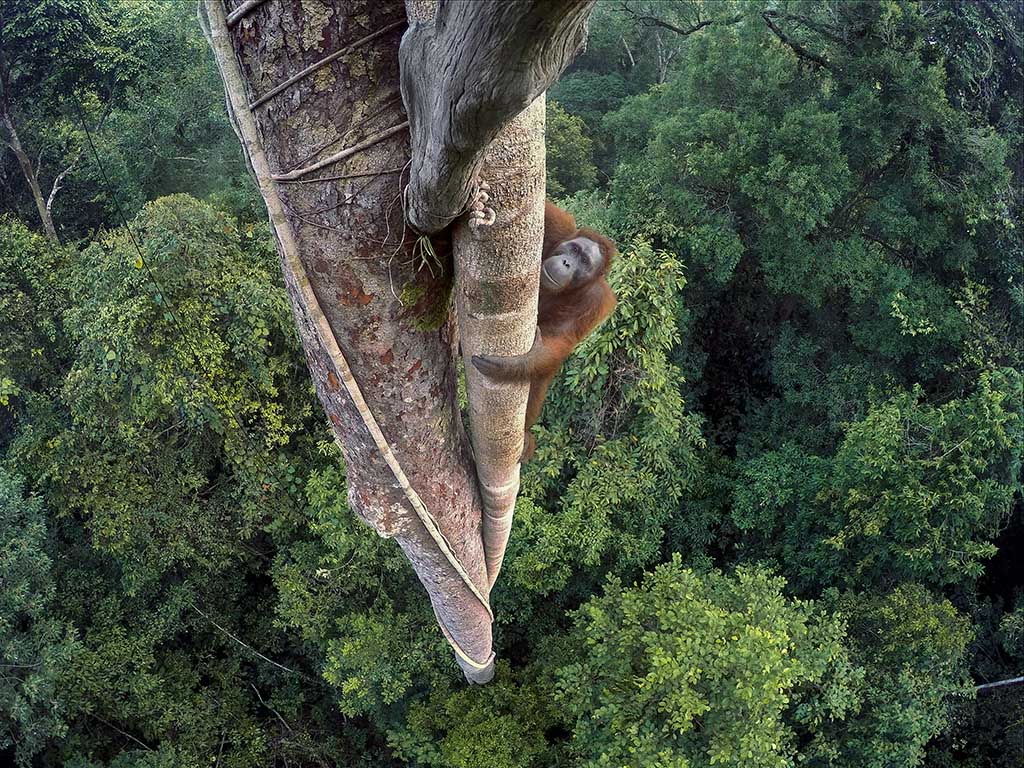
Tim Laman
USA
Winner, Wildlife Photographer of the Year 2016
A young male orangutan makes the 30-metre (100-foot) climb up the thickest root of the strangler fig that has entwined itself around a tree emerging high above the canopy. The backdrop is the rich rainforest of the Gunung Palung National Park, in West Kalimantan, one of the few protected orangutan strongholds in Indonesian Borneo. The orangutan has returned to feast on the crop of figs. He has a mental map of the likely fruiting trees in his huge range, and he has already feasted here. Tim knew he would return and, more important, that there was no way to reach the top – no route through the canopy – other than up the tree. But he had to do three days of climbing up and down himself, by rope, to place in position several GoPro cameras that he could trigger remotely to give him a chance of not only a wide‑angle view of the forest below but also a view of the orangutan’s face from above. This shot was the one he had long visualized, looking down on the orangutan within its forest home.
GoPro HERO4 Black; 1/30 sec at f2.8; ISO 231.
(Tim Laman)

Mats Andersson
SWEDEN
Winner, Black and White
Every day in early spring, Mats walked in the forest near his home in Bashult, southern Sweden, enjoying the company of a pair of Eurasian pygmy owls – until the night he found one of them lying dead on the forest floor. Pygmy owls, with their distinctive rounded heads and lack of ear tufts, are the smallest owls in Europe, barely 19 centimetres (7½ inches) long, though with large feet that enable them to carry prey almost as big as themselves. They also hunt in the day. Nesting in tree cavities, especially in conifer woodland, they form pair bonds in autumn that last through to spring and sometimes for more than one breeding season. ‘The owl’s resting posture reflected my sadness for its lost companion,’ recalls Mats. Preferring to work in black and white – ‘it conveys the feeling better’ – he captured the melancholy of the moment, framing the solitary owl within the bare branches, lit by the first light of dawn. Not long after, he found this owl dead, too, and suspects that it and its mate may have been killed by one of the larger owls in the forest, not for food but because, in the breeding season, it didn’t tolerate other birds of prey in its territory.
Nikon D4 + 300mm f2.8 lens + 2x extender; 1/160 sec at f5.6; ISO 400.
(Mats Andersson)
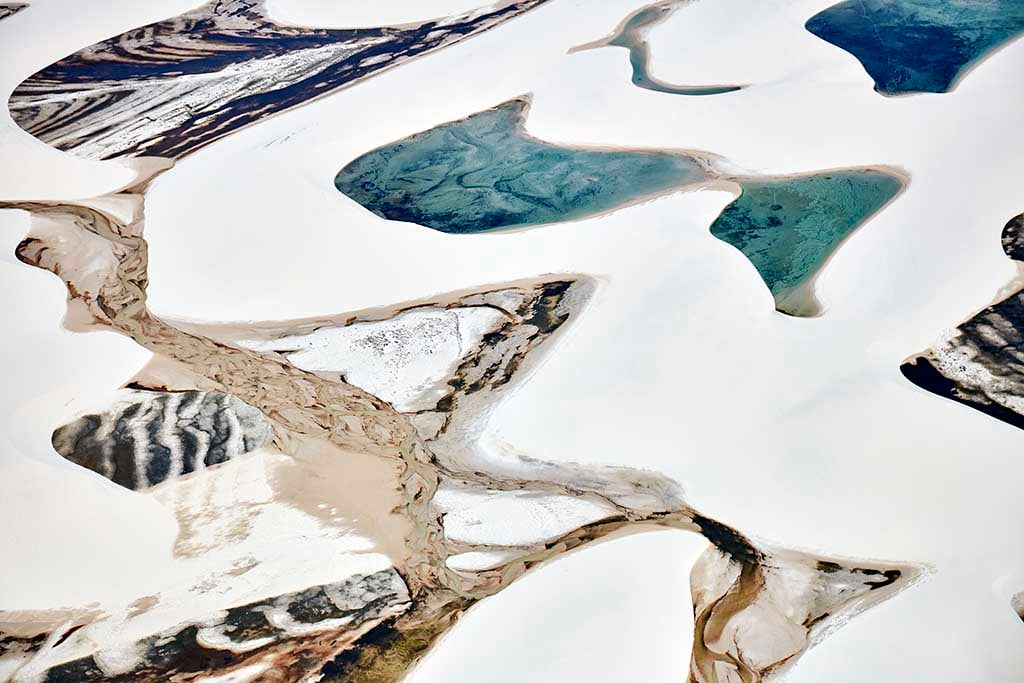
Rudi Sebastian
GERMANY
Winner, Details
The pristine white sand of Brazil’s Lençóis Maranhenses National Park offers a blank canvas to the rain. In the dry season, sand from the coast is blown by powerful Atlantic winds as far as 50 kilometres (30 miles) inland, sculpting a vast expanse of crescent-shaped dunes up to 40 metres (130 feet) high. With the onset of the rains, the magic begins. An impermeable layer beneath the sand allows water to collect in the dune valleys, forming thousands of transient lagoons, some more than 90 metres (295 feet) long. Bacteria and algae tint the clear water in countless shades of green and blue, while streams carrying sediment from the distant rainforest make their mark with browns and blacks. Patterns appear as the water evaporates, leaving behind organic remains. Rudi learned about the park on a TV programme, and realizing the photographic potential, planned his trip almost two years ahead, to make sure of the season and that he would have time to stay until the water level was right. He waited several days for the perfect light – overhead, to bring out the colours but with clouds obscuring any direct sun ‘to get a shadowless purity’. Shooting almost vertically down from a small aircraft with the door removed, avoiding perspective or scale, he created his striking image. A few weeks later, the scene had evaporated.
Canon EOS 5DS R + 24–70mm f4 lens at 70mm; 1/2000 at f5.6 (+0.3 e/v); ISO 320.
(Rudi Sebastian)
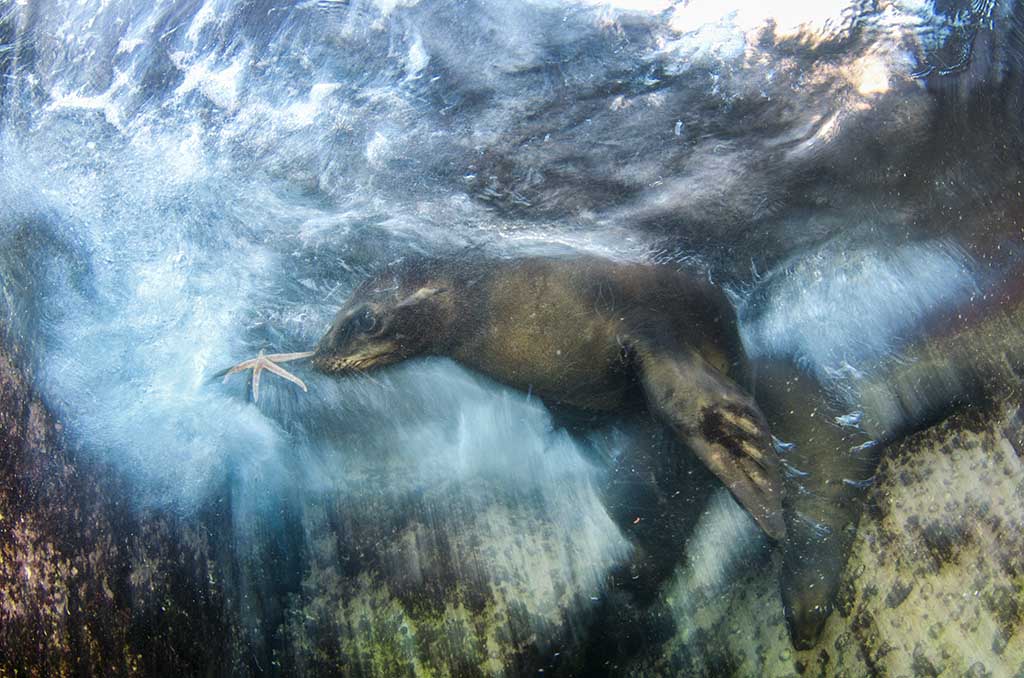
Luis Javier Sandoval
MEXICO
Winner, Impressions
As soon as Luis slipped into the water, the curious young California sea lions came over for a better look. He had arrived the night before at the island of Espíritu Santo in the Gulf of California, sleeping aboard his boat so that he would be ready to dive at sunrise. He had in mind a picture that needed warm light, a slow shutter speed and friendly subjects. One of the pups dived down, swimming gracefully with its strong fore-flippers (sea lions are also remarkably agile on land, since they can control each of their hind‑flippers independently). It grabbed a starfish from the bottom and started throwing it to Luis. ‘I love the way sea lions interact with divers and how smart they are,’ says Luis. The youngsters often use games to hone their skills, especially fishing techniques. As the pup was playing very close to the breaking point of the waves, Luis’s timing had to be spot-on to frame it in the right place against the movement of the water. Angling his camera up towards the dawn light – just as the pup offered him the starfish and another youngster slipped by close to the rocks – he created his artistic impression of the sea lion’s playful nature.
Nikon D7000 + Tokina 10–17mm f3.5–4.5 lens at 10mm; 1/8 sec at f13; ISO 100; Aquatica housing; two Sea & Sea YS-110 strobes.
(Luis Javier Sandoval)
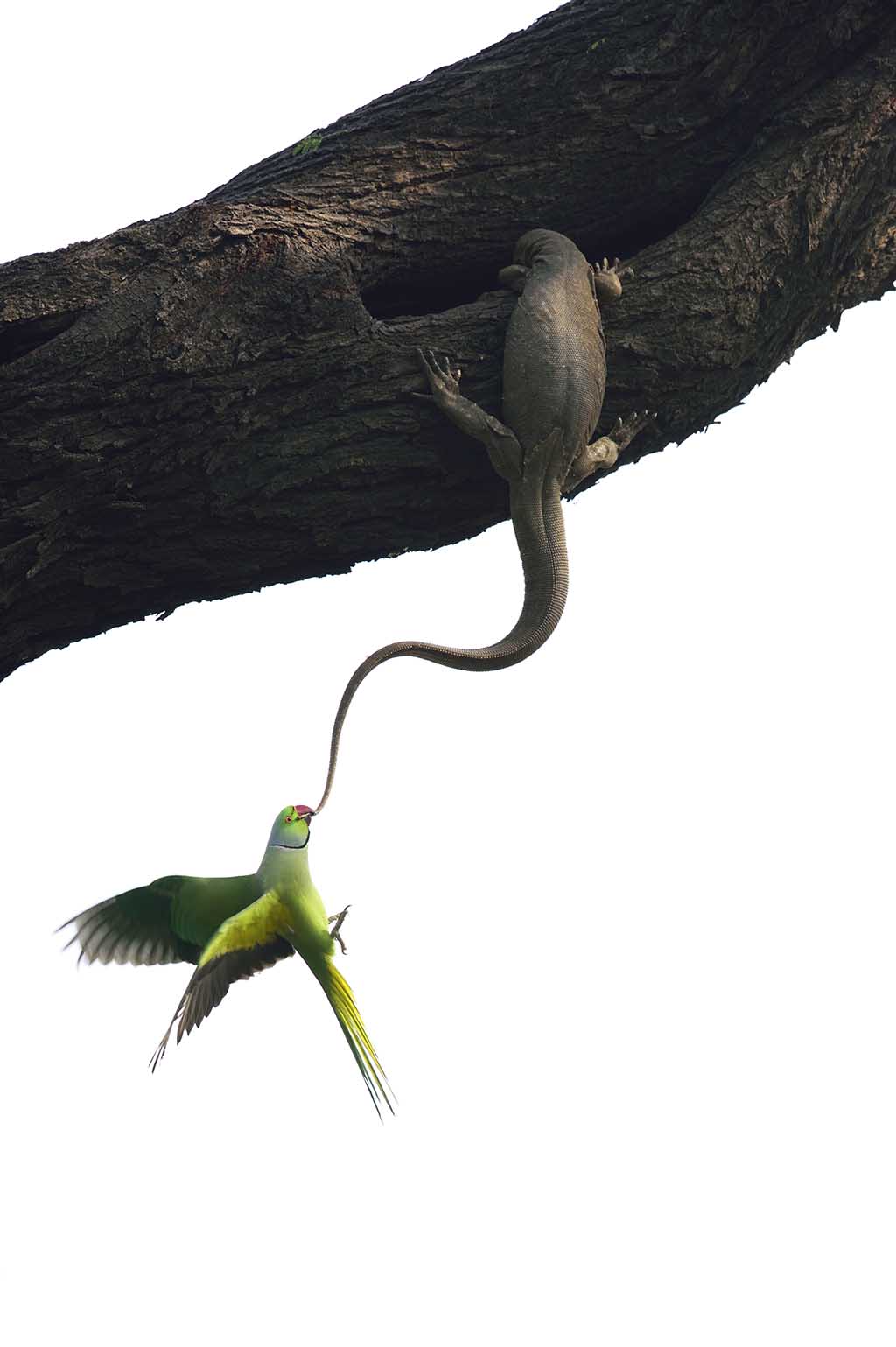
Ganesh H Shankar
INDIA
Winner, Birds
These Indian rose-ringed parakeets were not happy. They had returned to their roosting and nesting hole high up in a tree in India’s Keoladeo National Park (also known as Bharatpur Bird Sanctuary) to find that a Bengal monitor lizard had taken up residence. The birds immediately set about trying to evict the squatter. They bit the monitor lizard’s tail, hanging on for a couple of seconds at a time, until it retreated into the hole. They would then harass it when it tried to come out to bask. This went on for two days. But the action only lasted a couple of seconds at a time and was fast-moving. The branch was also high up, and Ganesh had to shoot against the light. Eventually the parakeets gave up and left, presumably to try to find another place to rear their young. These Indian birds are highly adaptable, and escaped captive parakeets have founded populations in many countries. In Europe, where they are known as ring-necked parakeets, they are accused of competing for nest holes with some native species, such as nuthatches, and even bats, but in turn, other birds such as starlings are quite capable of evicting the parakeets from their nest holes.
Nikon D810 + 200mm f2 lens; 1/500 sec at f5; ISO 400; Gitzo 5540LS tripod +
Sachtler 0707 FSB-8 fluid head.
(Ganesh H Shankar)
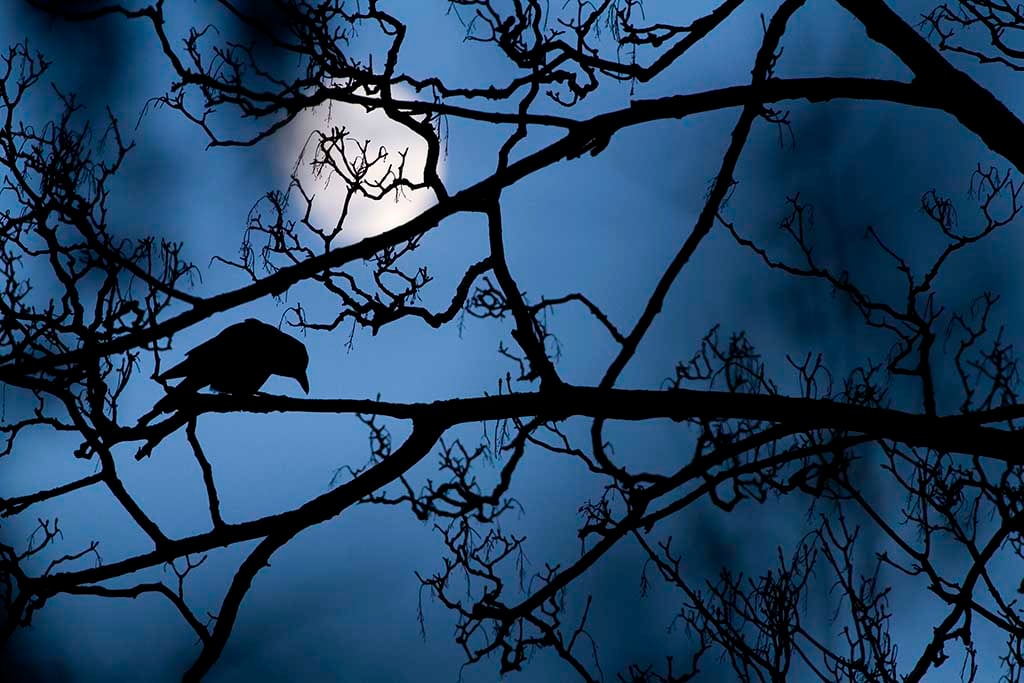
Gideon Knight
UK
Winner, Young Wildlife Photographer of the Year 2016
A crow in a tree in a park: a common enough scene. It was one that Gideon had seen many times near his home in London’s Valentines Park, which he visits regularly to take photographs. But as the blue light of dusk crept in and the full moon rose, the scene transformed. The spindly twigs of the sycamore tree silhouetted against the sky ‘made it feel almost supernatural, like something out of a fairy tale,’ says Gideon. Positioning himself on a slope opposite, he tried to capture the perfect composition. But the crow kept moving along the branch and turning its head away, and so getting a silhouette of it with the moon in the frame meant Gideon had to keep moving, too. Then, just as the light was about to fade beyond the point that photography was possible, his wish came true, and an ordinary London scene turned into something magical.
Canon EOS 7D Mark I + 400mm f5.6 lens; 1/250 sec at f6.3; ISO 500.
(Gideon Knight)

Nayan Khanolkar
INDIA
Winner, Urban
At night, in the Aarey Milk Colony in a suburb of Mumbai bordering Sanjay Gandhi National Park, leopards slip ghost-like through the maze of alleys, looking for food (especially stray dogs). The Warli people living in the area respect the big cats. Despite close encounters and occasional attacks (a particular spate coinciding with the relocation of leopards from other areas into the park), the cats are an accepted part of their lives and their culture, seen in the traditional paintings that decorate the walls of their homes. The leopard is not only the most versatile of the world’s big cats but possibly the most persecuted. With growing human-leopard conflicts elsewhere grabbing the headlines, Nayan was determined to use his pictures to show how things can be different with tolerance and planning. Once he had convinced the Warli people of his plan, they supplied him with valuable information, as well as keeping an eye on his equipment. Positioning his flashes to mimic the alley’s usual lighting and his camera so that a passing cat would not dominate the frame, he finally – after four months – got the shot he wanted. With a fleeting look of enquiry in the direction of the camera click, a leopard went about its business alongside people’s homes. Nayan hopes that those living in Mumbai’s new high-rise developments now impinging on the park will learn from the Warli how to co‑exist with the original inhabitants of the land.
Nikon D7000 + 18–105mm f3.5–5.6 lens at 21mm; 1/20 sec at f7.1; three Nikon flashes; Trailmaster infrared triggers; custom-made housing.
(Nayan Khanolkar)
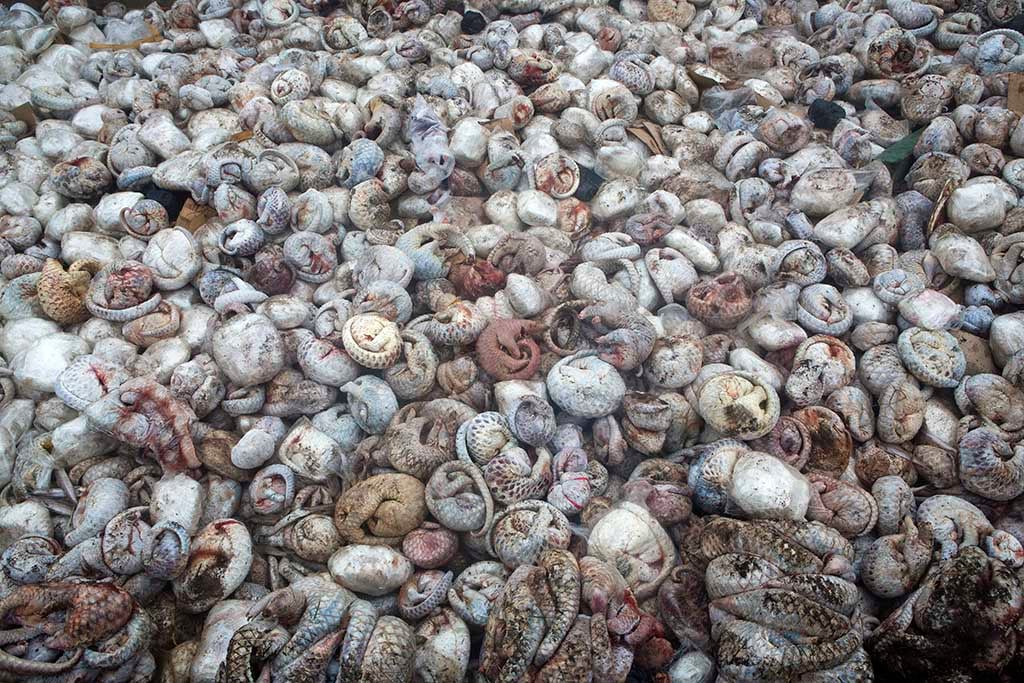
Paul Hilton
UK/AUSTRALIA
Winner, The Wildlife Photojournalist Award: Single image
Nothing prepared Paul for what he saw: some 4,000 defrosting pangolins (5 tons) from one of the largest seizures of the animals on record. They were destined for China and Vietnam for the exotic‑meat trade or for traditional medicine (their scales are thought, wrongly, to treat a variety of ailments). Pangolins have become the world’s most trafficked animals, with all eight species targeted. This illegal trade, along with habitat loss and local hunting, means that the four Asian species are now endangered or critically endangered, and Africa’s four species are heading that way. These Asian victims, mostly Sunda pangolins, were part of a huge seizure – a joint operation between Indonesia’s police and the World Conservation Society – found hidden in a shipping container behind a façade of frozen fish, ready for export from the major port of Belawan in Sumatra. Also seized were 96 live pangolins (destined to be force-fed to increase their size), along with 100 kilos (220 pounds) of pangolin scales (formed from keratin, the same substance in fingernails and rhino horn) worth some $1.8 million on the black market, and 24 bear paws. All had come from northern Sumatra. The dead pangolins were driven to a specially dug pit and then incinerated. The live ones were taken north and released in the rainforest. ‘Wildlife crime is big business,’ says Paul. ‘It will stop only when the demand stops.’
Canon EOS 5D Mark III + 16–35mm f2.8 lens at 21mm; 1/800 sec at f8; Manfrotto tripod.
(Paul Hilton)
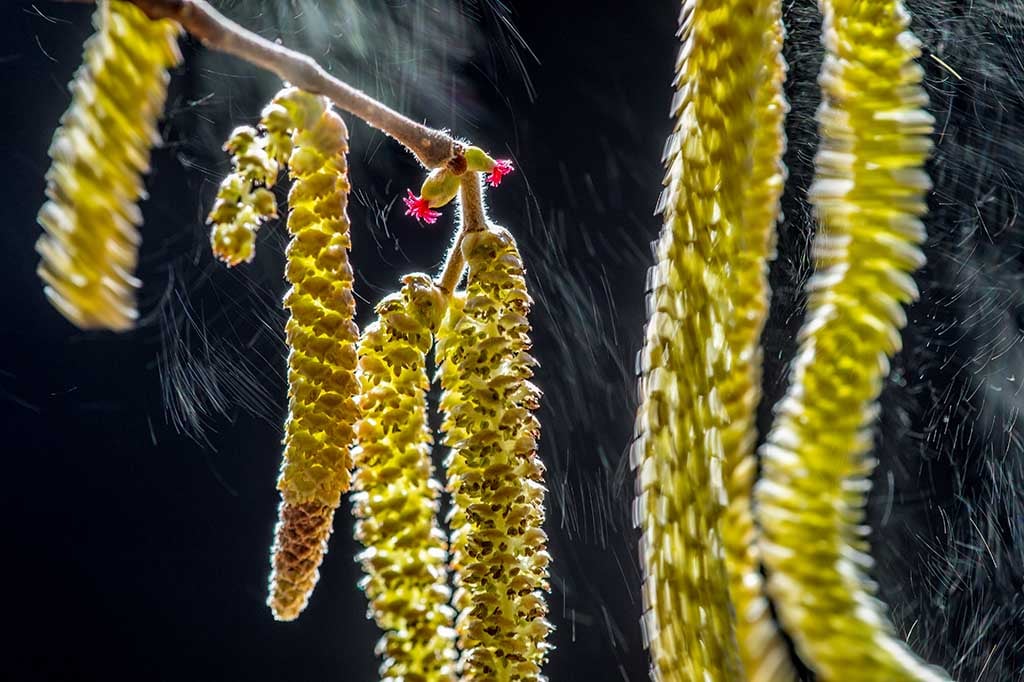
Valter Binotto
ITALY
Winner, Plants and Fungi
With every gust of wind, showers of pollen were released, lit up by the winter sunshine. The hazel tree was near Valter’s home in northern Italy, and to create the dark background, he positioned himself to backlight the flowers. Hazel has both male and female flowers on the same tree, though the pollen must be transferred between trees for fertilization. Each catkin comprises an average of 240 male flowers, while the female flower is a small bud-like structure with a red-tufted stigma. The pollen-producing catkins open early in the year, before the leaves are out, and release huge amounts of pollen to be carried away by the wind. And now recent research suggests that bees may also play a role. The catkins are an important source of pollen for early bees and have a bee‑friendly structure, while the red colour of the female flowers may entice insects to land on them. ‘The hardest part was capturing the female flowers motionless while the catkins were moving,’ explains Valter. ‘I searched for flowers on a short branch that was more stable.’ Using a long exposure to capture the pollen’s flight and a reflector to highlight the catkins, he took many pictures before the wind finally delivered the composition he had in mind.
Nikon D4 + 200mm f4 lens; 1/80 sec at f10; ISO 200; remote shutter release; Gitzo tripod + Benro head; reflector.
(Valter Binotto)